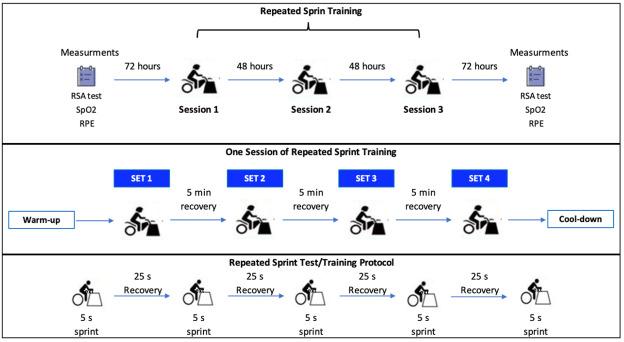Revolutionizing Athletic Training: The Influence of Environmental Conditions
A recent pioneering study featured in Frontiers has revealed important insights regarding how environmental factors affect the performance of athletes, notably those involved in team sports. This research investigates the effectiveness of short-term repeated-sprint training conducted under both hot and cool conditions, demonstrating that athletes can attain comparable performance improvements regardless of temperature. These findings not only challenge customary beliefs about optimal training environments but also pave the way for new strategies to boost athletic performance across various settings. As teams gear up for competitive seasons where weather conditions can fluctuate significantly, this research highlights the importance of adapting training programs to enhance athletes’ preparedness and resilience. Join us as we explore the implications of these findings for athletes, coaches, and trainers facing unpredictable weather challenges.
Temperature’s Role in Repeated-Sprint Training effectiveness
the latest research indicates that temperature does not substantially impede the effectiveness of repeated-sprint training among team sport athletes when performed in either warm or cool environments. concerns often arise regarding how high temperatures might lead to a decline in performance during activities requiring quick bursts of energy; however,this study found that athletes maintained similar levels of output across both scenarios. This adaptability suggests remarkable physiological resilience even under heat stress. Key elements contributing to this adaptability include:
- Hydration Techniques: Keeping fluid levels balanced is crucial for maintaining peak performance.
- Heat Acclimatization: athletes accustomed to training in warmer climates exhibited greater endurance.
- Cooling Methods: Utilizing pre-cooling strategies or active cooling during workouts enhanced sprinting capabilities.
This study emphasizes not only physical conditioning but also psychological fortitude through varied temperature exposure during training sessions.As teams prepare their players for competitions with diverse environmental challenges ahead, these insights provide valuable tactics for maximizing training efficiency. An analysis comparing performance metrics across different temperatures reveals:
| Environment Type | Sprinting average Time (s) | Percieved Exertion Level |
|---|---|---|
| Cooled Environment | 5.2 seconds | 7.5 out of 10 |
| warm Environment | 5.<3 seconds | 7.<7 out td/> |
Performance Enhancements for Team Athletes Under Diverse Conditions
The recent investigation underscores that engaging in short-term repeated-sprint workouts can effectively elevate team sport athlete performances irrespective of whether they are trained under hot or cool circumstances.The analysis focused on how environmental variables influence physiological responses and sprinting abilities among participants while revealing significant improvements from both settings.
Key advantages identified include:
- Boosted Aerobic Capacity : strong > Athletes showed a notable increase in VO2 max , essential for sustaining high-intensity efforts . li >
- < strong >Enhanced Anaerobic Power : strong > Engaging repeatedly sprints improved energy output during critical moments , vital within fast-paced sports . li >
- < strong >Faster Recovery Rates : strong > Those who trained under varying conditions experienced quicker recovery times , enabling them to maintain intensity throughout matches . li >
< / ul >A comparative review between hot versus cool environment trainings indicated minimal differences concerning sprint times while showcasing similar overall outcomes.
The following table summarizes key observed metrics from this study :
< / p >Condition th > VO2 Max (ml/kg/min) th > Anaerobic Power (W) th > Recovery Duration (seconds) th > tr > 56.< 2 860 45 < td />Cool 55.<8 850 44 tbody > table > This evidence highlights athlete adaptability when optimizing their performances amidst physiological hurdles posed by extreme temperatures.The positive results suggest effective trainings can occur within various environments without hindering athletic progress—encouraging a more flexible approach towards readiness and also competitive stances within team sports. p >
Coaching Strategies: Maximizing Training Environments For Optimal Results
coaches aiming at improving athlete outcomes should consider incorporating short-term repeated sprints into their routines regardless if it’s warm or cold outside .
Both types have shown equal potential benefits amongst team sport participants indicating manageable demands associated with such exercises across differing climates .
Thus coaches ought focus establishing protocols prioritizing hydration nutrition along with tailored recovery methods suited specifically towards each context .To further enhance these environments here are some practical recommendations :
- < strong>Pursue Cooling Techniques : strong Use ice vests shaded areas along with cooling towels whenever possible especially during hotter days .
- < strong>Create Hydration Stations : Strong Ensure easy access water electrolyte replenishment between sprints .
- < Strong>Evaluate Performance Regularly : Strong Consistently monitor sprinters’ performances alongside recovery metrics adjusting loads accordingly .
- Energize Education Programs For Athletes : teach pacing techniques emphasizing importance rest periods whether it’s sweltering heat chilly breezes .
Implementing these suggestions will help create supportive atmospheres mitigating adverse effects stemming from excessive warmth while simultaneously fostering improvement opportunities among competitors participating within group events .
Research indicates robust physiological gains derived through consistent practise remain resilient enough withstand fluctuations encountered throughout diverse climatic situations.Conclusion
To sum up , findings emerging from recent studies published via Frontiers illuminate pivotal roles played by surrounding elements impacting overall athletic efficacy .
Short term repeated sprint exercises yield substantial rewards irrespective climate type highlighting necessity personalized approaches tailored around individual needs based upon specific contexts faced daily by competing professionals alike .
As organizations strive gain competitive advantages understanding implications drawn forth could revolutionize existing methodologies applied universally spanning multiple disciplines alike moving forward into future endeavors aimed enhancing human capabilities beyond limits previously thought achievable!

